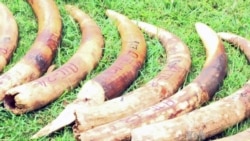NAIROBI —
Kenya's Wildlife Service (KWS) says authorities have intercepted 638 pieces of ivory tusks that were bound for Asia. The seizure follows a deadly year for Kenyan elephants, hunted for their tusks to satisfy customers in Asia.
Kenyan authorities in the port city of Mombasa Tuesday seized 638 pieces of ivory that were en route to Indonesia. The shipment is estimated to be worth more than $1 million.
KWS says the exporter, the clearing agent and the trucking company used to move the tusks were also linked to a massive ivory shipment seized in Hong Kong earlier this month.
Authorities say the packaging of the tusks indicated they may have come from Tanzania or Rwanda.
KWS Director William Kiprono told reporters in Nairobi Wednesday Kenya remains an important trade route for illicit ivory.
“In ivory trafficking, both Kenyan citizens and foreigners are involved and the destination of the ivory and rhino horns is mainly outside the country,” said Kiprono.
KWS says some of the ivory pieces seized in Kenya last year were in transit from Angola, South Sudan, Zambia, the Democratic Republic of Congo. It says the ivory was destined for China, Nigeria, Malaysia and Thailand.
Kenyan elephants have suffered a heavy cost at the hands of poachers, who are motivated by the rising price of ivory, which can sell for up to $1,000 per kilogram.
According to KWS, 384 elephants were killed in the country in 2012, which is nearly 100 more than were poached the previous year. Nineteen rhinos were also killed.
Kiprono blamed surging demand for ivory from the East.
“The price of ivory and rhino horn continues to rise by day leading to increased poaching of elephants and rhinos,” said Kiprono. "Growing influence and economic growth in the far east and Southeast Asian countries has increased demand for natural resources, including an increased demand for wildlife and wildlife products.”
In an emotional plea for the world to take the poaching menace seriously, Kiprono said killing an elephant is like killing a human being.
“Let me share with you, when they die, some of them die crying. When the rhinos, they die kneeling and crying and facing the east. And you know about the elephants - when they die also what happens, when the mass is killed, what happens is they shoot one, and they don't run away, they start crying and surrounding the others, so as they are surrounding they are also being shot,” said Kiprono.
Meantime, 2013 is off to an ominous start. Already, 19 elephants have been killed in Kenya, including a family of 11 shot by a gang of poachers in Tsavo East National Park.
KWS says one suspect has been arrested in that incident. Investigators are still looking into how it happened, including the possibility that the poachers fired on the animals from a helicopter.
Kenyan authorities in the port city of Mombasa Tuesday seized 638 pieces of ivory that were en route to Indonesia. The shipment is estimated to be worth more than $1 million.
KWS says the exporter, the clearing agent and the trucking company used to move the tusks were also linked to a massive ivory shipment seized in Hong Kong earlier this month.
Authorities say the packaging of the tusks indicated they may have come from Tanzania or Rwanda.
KWS Director William Kiprono told reporters in Nairobi Wednesday Kenya remains an important trade route for illicit ivory.
“In ivory trafficking, both Kenyan citizens and foreigners are involved and the destination of the ivory and rhino horns is mainly outside the country,” said Kiprono.
KWS says some of the ivory pieces seized in Kenya last year were in transit from Angola, South Sudan, Zambia, the Democratic Republic of Congo. It says the ivory was destined for China, Nigeria, Malaysia and Thailand.
Kenyan elephants have suffered a heavy cost at the hands of poachers, who are motivated by the rising price of ivory, which can sell for up to $1,000 per kilogram.
According to KWS, 384 elephants were killed in the country in 2012, which is nearly 100 more than were poached the previous year. Nineteen rhinos were also killed.
Kiprono blamed surging demand for ivory from the East.
“The price of ivory and rhino horn continues to rise by day leading to increased poaching of elephants and rhinos,” said Kiprono. "Growing influence and economic growth in the far east and Southeast Asian countries has increased demand for natural resources, including an increased demand for wildlife and wildlife products.”
In an emotional plea for the world to take the poaching menace seriously, Kiprono said killing an elephant is like killing a human being.
“Let me share with you, when they die, some of them die crying. When the rhinos, they die kneeling and crying and facing the east. And you know about the elephants - when they die also what happens, when the mass is killed, what happens is they shoot one, and they don't run away, they start crying and surrounding the others, so as they are surrounding they are also being shot,” said Kiprono.
Meantime, 2013 is off to an ominous start. Already, 19 elephants have been killed in Kenya, including a family of 11 shot by a gang of poachers in Tsavo East National Park.
KWS says one suspect has been arrested in that incident. Investigators are still looking into how it happened, including the possibility that the poachers fired on the animals from a helicopter.







